Long-Term Changes in the Pollution of Warta River Bottom Sediments with Heavy Metals, Poland—Case Study
Abstract
1. Introduction
2. Materials and Methods
2.1. Object Description
2.2. Materials
2.3. Methodology
2.3.1. Primary Statistics
2.3.2. Geoaccumulation Index (Igeo)
2.3.3. Enrichment Factor (EF)
2.3.4. Potential Ecological Risk (RI)
2.3.5. Toxic Risk Index
2.3.6. Land Use
3. Results
3.1. General Characteristics
3.2. Assessment of the Pollution of Bottom Sediments with Metals
3.3. Potential Environmental Risk of Heavy Metals
3.4. Influence of Heavy Metals on Aquatic Organisms
3.5. Analysis of the Impact of Land Use on Heavy Metal Concentrations
4. Conclusions
Funding
Data Availability Statement
Conflicts of Interest
Appendix A
| Year | Sampling Sites |
|---|---|
| 2010 | 1, 2, 3, 5, 6, 7, 9, 10, 11, 13, 15, 16, 18, 19, 22, 27, 29, 30, 32, 33, 34, 35 |
| 2011 | 2, 3, 5, 6, 7, 9, 10, 11, 13, 15, 16, 18, 19, 22, 27, 29, 30, 32, 33, 34, 35 |
| 2012 | 2, 3, 5, 6, 7, 9, 10, 11, 13, 15, 16, 18, 19, 22, 24, 27, 29, 30, 32, 33, 34, 35 |
| 2013 | 1, 2, 3, 5, 6, 7, 9, 10, 11, 13, 15, 16, 18, 19, 22, 24, 27, 29, 30, 32, 33, 34, 35 |
| 2014 | 1, 2, 3, 7, 9, 10, 11, 13, 15, 18, 19, 22, 27, 29, 30, 32, 33, 34, 35 |
| 2015 | 1, 2, 3, 5, 6, 7, 9, 10, 11, 13, 15, 16, 18, 19, 22, 24, 27, 29, 30, 32, 33, 34, 35 |
| 2016 | 1, 2, 3, 5, 6, 7, 9, 10, 11, 13, 15, 16, 18, 19, 22, 24, 27, 29, 30, 32, 33, 34, 35 |
| 2017 | 1, 2, 3, 5, 6, 7, 9, 10, 11, 13, 15, 16, 18, 19, 22, 24, 27, 29, 30, 32, 33, 34, 35 |
| 2018 | 3, 7, 8, 12, 17, 23, 35 |
| 2019 | 2, 20, 23, 33, 34 |
| 2020 | 2, 4, 7, 8, 12, 14, 16, 17, 21, 23, 25, 26, 27, 28, 31 |
| 2021 | 2, 4, 7, 8, 12, 14, 16, 17, 21, 23, 26, 28 |
| Pollution Index | Class | Value | Description | Reference |
|---|---|---|---|---|
| Igeo | 0 | Igeo ≤ 0 | Practically unpolluted | Müller (1986) [73] |
| 1 | 0 < Igeo ≤ 1 | Unpolluted to moderately polluted | ||
| 2 | 1 < Igeo ≤ 2 | Moderately polluted | ||
| 3 | 2 < Igeo ≤ 3 | Moderately severe polluted | ||
| 4 | 3 < Igeo ≤ 4 | Severely polluted | ||
| 5 | 4 < Igeo ≤ 5 | Very severely polluted | ||
| 6 | 5 < Igeo | Extremely polluted | ||
| EF | 0 | EF ≤ 2 | Deficiency to minimal enrichment | Barbieri (2016) [35] |
| 1 | 2 < EF ≤ 5 | Moderate enrichment | ||
| 2 | 5 < EF ≤ 20 | Significant enrichment | ||
| 3 | 20 < EF ≤ 40 | Very high enrichment | ||
| 4 | 40 < EF | Extremely high enrichment | ||
| 0 | ≤ 40 | Low risk | Håkanson (1980) [34] | |
| 1 | 40 < ≤ 80 | Moderate risk | ||
| 2 | 80 < ≤ 160 | High risk | ||
| 3 | 160 < ≤ 320 | Very high risk | ||
| 4 | 320 < | Extremely high risk | ||
| RI | 0 | RI ≤ 150 | Low risk | Håkanson (1980) [34] |
| 1 | 150 < RI ≤ 300 | Moderate risk | ||
| 2 | 300 < RI ≤ 600 | High risk | ||
| 3 | 600 < RI | Very high risk | ||
| TRI | 0 | TRI ≤ 5 | No toxicity risk | Zhang et al. (2016) [74] |
| 1 | 5 < TRI ≤ 10 | Low risk | ||
| 2 | 10 < TRI ≤ 15 | Moderate risk | ||
| 3 | 15 < TRI ≤ 20 | Considerable risk | ||
| 4 | 20 < TRI | Very high risk |
References
- Bryan, G.W.; Langston, W.J. Bioavailability, accumulation and effects of heavy metals in sediments with special reference to United Kingdom estuaries: A review. Environ. Pollut. 1992, 76, 89–131. [Google Scholar] [CrossRef] [PubMed]
- Khan, A.; Khan, S.; Khan, M.A.; Qamar, Z.; Waqas, M. The uptake and bioaccumulation of heavy metals by food plants, their effects on plants nutrients, and associated health risk: A review. Environ. Sci. Pollut. Res. 2015, 22, 13772–13799. [Google Scholar] [CrossRef] [PubMed]
- Varol, M. Assessment of heavy metal contamination in sediments of the Tigris River (Turkey) using pollution indices and multivariate statistical techniques. J. Hazard. Mater. 2011, 195, 355–364. [Google Scholar] [CrossRef]
- Tarras-Wahlberg, N.H.; Flachier, A.; Lane, S.N.; Sangfors, O. Environmental impacts and metal exposure of aquatic ecosystems in rivers contaminated by small scale gold mining: The Puyango River basin, southern Ecuador. Sci. Total. Environ. 2001, 278, 239–261. [Google Scholar] [CrossRef] [PubMed]
- Jackson, T.A. Sources of heavy metal contamination in a river-lake system. Environ. Pollut. (1970) 1979, 18, 131–138. [Google Scholar] [CrossRef]
- Williams, S.C.; Simpson, H.J.; Olsen, C.R.; Bopp, R.F. Sources of heavy metals in sediments of the Hudson river Estuary. Mar. Chem. 1978, 6, 195–213. [Google Scholar] [CrossRef]
- Gunes, G. The change of metal pollution in the water and sediment of the Bartın River in rainy and dry seasons. Environ. Eng. Res. 2021, 27, 200701. [Google Scholar] [CrossRef]
- Mokarram, M.; Saber, A.; Sheykhi, V. Effects of heavy metal contamination on river water quality due to release of industrial effluents. J. Clean. Prod. 2020, 277, 123380. [Google Scholar] [CrossRef]
- Yao, Q.; Chen, L.; Mao, L.; Ma, Y.; Tian, F.; Wang, R.; Meng, X.-Z.; Li, F. Co-Effects of Hydrological Conditions and Industrial Activities on the Distribution of Heavy Metal Pollution in Taipu River, China. Int. J. Environ. Res. Public Health. 2022, 19, 10116. [Google Scholar] [CrossRef]
- Bussan, D.; Harris, A.; Douvris, C. Monitoring of selected trace elements in sediments of heavily industrialized areas in Calcasieu Parish, Louisiana, United States by inductively coupled plasma-optical emission spectroscopy (ICP-OES). Microchem. J. 2019, 144, 51–55. [Google Scholar] [CrossRef]
- Tokatlı, C.; Varol, M. Variations, health risks, pollution status and possible sources of dissolved toxic metal(loid)s in stagnant water bodies located in an intensive agricultural region of Turkey. Environ. Res. 2021, 201, 111571. [Google Scholar] [CrossRef]
- Tang, W.; Ao, L.; Zhang, H.; Shan, B. Accumulation and risk of heavy metals in relation to agricultural intensification in the river sediments of agricultural regions. Environ. Earth Sci. 2014, 71, 3945–3951. [Google Scholar] [CrossRef]
- Feng, H.; Han, X.; Zhang, W.; Yu, L. A preliminary study of heavy metal contamination in Yangtze River intertidal zone due to urbanization. Mar. Pollut. Bull. 2004, 49, 910–915. [Google Scholar] [CrossRef]
- Wang, F.; Dong, W.; Zhao, Z.; Wang, H.; Li, W.; Chen, G.; Wang, F.; Zhao, Y.; Huang, J.; Zhou, T. Heavy metal pollution in urban river sediment of different urban functional areas and its influence on microbial community structure. Sci. Total. Environ. 2021, 778, 146383. [Google Scholar] [CrossRef]
- Rybicka, E.H. Impact of mining and metallurgical industries on the environment in Poland. Appl. Geochem. 1996, 11, 3–9. [Google Scholar] [CrossRef]
- Banze wa Mutombo, A.B.W.; Atibu, E.K.; Mbuya wa Mutombo, J.M.W.; Kalonda, E.M.; Bakatula, E.N.; Kanda, V.N.; Koy, R.K.; Mulaji, C.K.; Carvalho, F.P.; Poté, J. Contamination by heavy metals from mining activities: An ecological impact assessment of Mura and Kimpulande Rivers, Democratic Republic of the Congo. Watershed Ecol. Environ. 2022, 4, 148–157. [Google Scholar] [CrossRef]
- Duncan, A.E.; de Vries, N.; Nyarko, K.B. Assessment of Heavy Metal Pollution in the Sediments of the River Pra and Its Tributaries. Water, Air, Soil Pollut. 2018, 229, 272. [Google Scholar] [CrossRef] [PubMed]
- Zhao, Y.; Marriott, S.B. Dispersion and Remobilisation of Heavy Metals in the River Severn System, UK. Procedia Environ. Sci. 2013, 18, 167–173. [Google Scholar] [CrossRef]
- Ciszewski, D.; Grygar, T.M. A Review of Flood-Related Storage and Remobilization of Heavy Metal Pollutants in River Systems. Water, Air, Soil Pollut. 2016, 227, 239. [Google Scholar] [CrossRef] [PubMed]
- Zhuang, Q.; Li, G.; Liu, Z. Distribution, source and pollution level of heavy metals in river sediments from South China. Catena 2018, 170, 386–396. [Google Scholar] [CrossRef]
- Wang, J.; Liu, R.; Zhang, P.; Yu, W.; Shen, Z.; Feng, C. Spatial variation, environmental assessment and source identification of heavy metals in sediments of the Yangtze River Estuary. Mar. Pollut. Bull. 2014, 87, 364–373. [Google Scholar] [CrossRef]
- Kałmykow-Piwińska, A.; Falkowska, E. Morphodynamic conditions of heavy metal concentration in deposits of the Vistula River valley near Kępa Gostecka (central Poland). Open Geosci. 2020, 12, 1036–1051. [Google Scholar] [CrossRef]
- Lin, J.-G.; Chen, S.-Y. The relationship between adsorption of heavy metal and organic matter in river sediments. Environ. Int. 1998, 24, 345–352. [Google Scholar] [CrossRef]
- Torres-Bejarano, F.; Couder-Castañeda, C.; Ramírez-León, H.; Hernández-Gómez, J.J.; Rodríguez-Cuevas, C.; Herrera-Díaz, I.E.; Barrios-Piña, H. Numerical Modelling of Heavy Metal Dynamics in a River-Lagoon System. Math. Probl. Eng. 2019, 2019, 1–24. [Google Scholar] [CrossRef]
- Geng, N.; Bai, Y.; Pan, S. Research on heavy metal release with suspended sediment in Taihu Lake under hydrodynamic condition. Environ. Sci. Pollut. Res. 2022, 29, 28588–28597. [Google Scholar] [CrossRef] [PubMed]
- Huang, J.; Ge, X.; Wang, D. Distribution of heavy metals in the water column, suspended particulate matters and the sediment under hydrodynamic conditions using an annular flume. J. Environ. Sci. 2012, 24, 2051–2059. [Google Scholar] [CrossRef]
- Liu, M.; He, Y.; Baumann, Z.; Zhang, Q.; Jing, X.; Mason, R.P.; Xie, H.; Shen, H.; Chen, L.; Zhang, W.; et al. The impact of the Three Gorges Dam on the fate of metal contaminants across the river–ocean continuum. Water Res. 2020, 185, 116295. [Google Scholar] [CrossRef]
- Sundaray, S.K.; Nayak, B.B.; Lin, S.; Bhatta, D. Geochemical speciation and risk assessment of heavy metals in the river estuarine sediments—A case study: Mahanadi basin, India. J. Hazard. Mater. 2011, 186, 1837–1846. [Google Scholar] [CrossRef]
- Chon, H.-S.; Ohandja, D.-G.; Voulvoulis, N. The role of sediments as a source of metals in river catchments. Chemosphere 2012, 88, 1250–1256. [Google Scholar] [CrossRef]
- Shyleshchandran, M.N.; Mohan, M.; Ramasamy, E.V. Risk assessment of heavy metals in Vembanad Lake sediments (south-west coast of India), based on acid-volatile sulfide (AVS)-simultaneously extracted metal (SEM) approach. Environ. Sci. Pollut. Res. 2018, 25, 7333–7345. [Google Scholar] [CrossRef]
- Sojka, M.; Choiński, A.; Ptak, M.; Siepak, M. Causes of variations of trace and rare earth elements concentration in lakes bottom sediments in the Bory Tucholskie National Park, Poland. Sci. Rep. 2021, 11, 1–18. [Google Scholar] [CrossRef]
- Kuriata-Potasznik, A.; Szymczyk, S.; Skwierawski, A.; Glińska-Lewczuk, K.; Cymes, I. Heavy Metal Contamination in the Surface Layer of Bottom Sediments in a Flow-Through Lake: A Case Study of Lake Symsar in Northern Poland. Water 2016, 8, 358. [Google Scholar] [CrossRef]
- Muller, G. Index of Geoaccumulation in Sediments of the Rhine River. Geo J. 1969, 2, 108–118. [Google Scholar]
- Håkanson, L. An ecological risk index for aquatic pollution control. A sedimentological approach. Water Res. 1980, 14, 975–1001. [Google Scholar] [CrossRef]
- Barbieri, M. The Importance of Enrichment Factor (EF) and Geoaccumulation Index (Igeo) to Evaluate the Soil Contamination. J. Geol. Geophys. 2016, 5, 1–4. [Google Scholar] [CrossRef]
- Yan, Y.; Han, L.; Yu, R.-L.; Hu, G.-R.; Zhang, W.-F.; Cui, J.-Y.; Yan, Y.; Huang, H.-B. Background determination, pollution assessment and source analysis of heavy metals in estuarine sediments from Quanzhou Bay, southeast China. Catena 2019, 187, 104322. [Google Scholar] [CrossRef]
- Wu, Q.; Qi, J.; Xia, X. Long-term variations in sediment heavy metals of a reservoir with changing trophic states: Implications for the impact of climate change. Sci. Total. Environ. 2017, 609, 242–250. [Google Scholar] [CrossRef]
- El-Alfy, M.A.; El-Amier, Y.A.; El-Eraky, T.E. Land use/cover and eco-toxicity indices for identifying metal contamination in sediments of drains, Manzala Lake, Egypt. Heliyon 2020, 6, e03177. [Google Scholar] [CrossRef] [PubMed]
- Sojka, M.; Jaskuła, J. Heavy Metals in River Sediments: Contamination, Toxicity, and Source Identification—A Case Study from Poland. Int. J. Environ. Res. Public Health. 2022, 19, 10502. [Google Scholar] [CrossRef]
- Jaskuła, J.; Sojka, M. Assessment of spatial distribution of sediment contamination with heavy metals in the two biggest rivers in Poland. Catena 2021, 211, 105959. [Google Scholar] [CrossRef]
- Bojakowska, I.; Sokołowska, G.; Gliwicz, T. Heavy Metals in Recent Alluvium of the Odra River. Geol. Q. 1997, 41, 395–404. [Google Scholar]
- Jaishankar, M.; Tseten, T.; Anbalagan, N.; Mathew, B.B.; Beeregowda, K.N. Toxicity, mechanism and health effects of some heavy metals. Interdiscip. Toxicol. 2014, 7, 60–72. [Google Scholar] [CrossRef] [PubMed]
- Li, Y.; Chen, H.; Song, L.; Wu, J.; Sun, W.; Teng, Y. Effects on microbiomes and resistomes and the source-specific ecological risks of heavy metals in the sediments of an urban river. J. Hazard. Mater. 2020, 409, 124472. [Google Scholar] [CrossRef] [PubMed]
- Magni, L.F.; Castro, L.N.; Rendina, A.E. Evaluation of heavy metal contamination levels in river sediments and their risk to human health in urban areas: A case study in the Matanza-Riachuelo Basin, Argentina. Environ. Res. 2021, 197, 110979. [Google Scholar] [CrossRef] [PubMed]
- Witkowska, D.; Słowik, J.; Chilicka, K. Heavy Metals and Human Health: Possible Exposure Pathways and the Competition for Protein Binding Sites. Molecules 2021, 26, 6060. [Google Scholar] [CrossRef]
- Balali-Mood, M.; Naseri, K.; Tahergorabi, Z.; Khazdair, M.R.; Sadeghi, M. Toxic Mechanisms of Five Heavy Metals: Mercury, Lead, Chromium, Cadmium, and Arsenic. Front. Pharmacol. 2021, 12, 227. [Google Scholar] [CrossRef]
- Azevedo, B.F.; Furieri, L.B.; Peçanha, F.M.; Wiggers, G.A.; Vassallo, P.F.; Simões, M.R.; Fiorim, J.; de Batista, P.R.; Fioresi, M.; Rossoni, L.; et al. Toxic Effects of Mercury on the Cardiovascular and Central Nervous Systems. J. Biomed. Biotechnol. 2012, 2012, 1–11. [Google Scholar] [CrossRef]
- Hoang, H.-G.; Chiang, C.-F.; Lin, C.; Wu, C.-Y.; Lee, C.-W.; Cheruiyot, N.K.; Tran, H.-T.; Bui, X.-T. Human health risk simulation and assessment of heavy metal contamination in a river affected by industrial activities. Environ. Pollut. 2021, 285, 117414. [Google Scholar] [CrossRef]
- Ilnicki, P.; Górecki, K.; Melcer, B. Eutrophication of Rivers in the Warta Catchment in 1992–2002; Poznań University of Life Sciences: Poznań, Poland, 2008; ISBN 978-83-7160-531-4. [Google Scholar]
- Fiedler, M. The Effects of Land Use on Concentrations of Nutrients and Selected Metals in Bottom Sediments and the Risk Assessment for Rivers of the Warta River Catchment, Poland. Land 2021, 10, 589. [Google Scholar] [CrossRef]
- Feranec, J.; Soukup, T.; Hazeu, G.; Jaffrain, G. (Eds.) European Landscape Dynamics; CRC Press: Boca Raton, FL, USA, 2016; ISBN 978-1-4822-4468-7. [Google Scholar]
- Aune-Lundberg, L.; Strand, G.-H. The content and accuracy of the CORINE Land Cover dataset for Norway. Int. J. Appl. Earth Obs. Geoinformation 2021, 96, 102266. [Google Scholar] [CrossRef]
- Kowalska, J.B.; Mazurek, R.; Gąsiorek, M.; Zaleski, T. Pollution indices as useful tools for the comprehensive evaluation of the degree of soil contamination–A review. Environ. Geochem. Health. 2018, 40, 2395–2420. [Google Scholar] [CrossRef] [PubMed]
- Håkanson, L.; Jansson, M. Principles of lake sedimentology. Vol. 316.; Springer: Berlin, Germany, 1983. [Google Scholar]
- MacDonald, D.D.; Ingersoll, C.G.; Berger, T.A. Development and Evaluation of Consensus-Based Sediment Quality Guidelines for Freshwater Ecosystems. Arch. Environ. Contam. Toxicol. 2000, 39, 20–31. [Google Scholar] [CrossRef]
- Smith, S.L.; MacDonald, D.D.; Keenleyside, K.A.; Ingersoll, C.G.; Field, L.J. A Preliminary Evaluation of Sediment Quality Assessment Values for Freshwater Ecosystems. J. Great Lakes Res. 1996, 22, 624–638. [Google Scholar] [CrossRef]
- Ibragimow, A.; Głosińska, G.; Siepak, M.; Walna, B. Heavy metals in fluvial sediments of the Odra River flood plains - introductory research. Quaest. Geogr. 2010, 29, 37–47. [Google Scholar] [CrossRef]
- Jaskuła, J.; Sojka, M.; Fiedler, M.; Wróżyński, R. Analysis of Spatial Variability of River Bottom Sediment Pollution with Heavy Metals and Assessment of Potential Ecological Hazard for the Warta River, Poland. Minerals 2021, 11, 327. [Google Scholar] [CrossRef]
- Sakan, S.M.; Đorđević, D.S.; Manojlović, D.D.; Predrag, P.S. Assessment of heavy metal pollutants accumulation in the Tisza river sediments. J. Environ. Manag. 2009, 90, 3382–3390. [Google Scholar] [CrossRef] [PubMed]
- Vink, R.; Behrendt, H.; Salomons, W. Point and diffuse source analysis of heavy metals in the Elbe drainage area: Comparing heavy metal emissions with transported river loads. Hydrobiologia 1999, 410, 307–314. [Google Scholar] [CrossRef]
- Zhang, W.; Feng, H.; Chang, J.; Qu, J.; Xie, H.; Yu, L. Heavy metal contamination in surface sediments of Yangtze River intertidal zone: An assessment from different indexes. Environ. Pollut. 2009, 157, 1533–1543. [Google Scholar] [CrossRef]
- Sun, W.; Yang, K.; Li, R.; Chen, T.; Xia, L.; Sun, X.; Wang, Z. Distribution characteristics and ecological risk assessment of heavy metals in sediments of Shahe reservoir. Sci. Rep. 2022, 12, 16239. [Google Scholar] [CrossRef]
- Cui, S.; Zhang, F.; Hu, P.; Hough, R.; Fu, Q.; Zhang, Z.; An, L.; Li, Y.-F.; Li, K.; Liu, D.; et al. Heavy Metals in Sediment from the Urban and Rural Rivers in Harbin City, Northeast China. Int. J. Environ. Res. Public Health. 2019, 16, 4313. [Google Scholar] [CrossRef]
- Li, H.; Shi, A.; Li, M.; Zhang, X. Effect of pH, Temperature, Dissolved Oxygen, and Flow Rate of Overlying Water on Heavy Metals Release from Storm Sewer Sediments. J. Chem. 2013, 2013, 1–11. [Google Scholar] [CrossRef]
- Mohammadi, M.; Darvishan, A.K.; Bahramifar, N. Spatial distribution and source identification of heavy metals (As, Cr, Cu and Ni) at sub-watershed scale using geographically weighted regression. Int. Soil Water Conserv. Res. 2019, 7, 308–315. [Google Scholar] [CrossRef]
- Jiang, Y.; Gui, H.; Chen, C.; Wang, C.; Zhang, Y.; Huang, Y.; Yu, H.; Wang, M.; Fang, H.; Qiu, H. The Characteristics and Source Analysis of Heavy Metals in the Sediment of Water Area of Urban Scenic: A Case Study of the Delta Park in Suzhou City, Anhui Province, China. Pol. J. Environ. Stud. 2021, 30, 2127–2136. [Google Scholar] [CrossRef]
- Pińskwar, I.; Choryński, A.; Graczyk, D.; Kundzewicz, Z.W. Observed changes in extreme precipitation in Poland: 1991–2015 versus 1961–1990. Theor. Appl. Clim. 2018, 135, 773–787. [Google Scholar] [CrossRef]
- Ogolo, E.O.; Matthew, O.J. Spatial and temporal analysis of observed trends in extreme precipitation events in different climatic zones of Nigeria. Theor. Appl. Clim. 2022, 148, 1335–1351. [Google Scholar] [CrossRef]
- Zakizadeh, H.R.; Ahmadi, H.; Zehtabiyan, G.R.; Moeini, A.; Moghaddamnia, A. Impact of climate change on surface runoff: A case study of the Darabad River, northeast of Iran. J. Water Clim. Chang. 2020, 12, 82–100. [Google Scholar] [CrossRef]
- Seybold, E.C.; Dwivedi, R.; Musselman, K.N.; Kincaid, D.W.; Schroth, A.W.; Classen, A.T.; Perdrial, J.N.; Adair, E.C. Winter runoff events pose an unquantified continental-scale risk of high wintertime nutrient export. Environ. Res. Lett. 2022, 17, 104044. [Google Scholar] [CrossRef]
- Choryński, A.; Pińskwar, I.; Graczyk, D.; Krzyżaniak, M. The Emergence of Different Local Resilience Arrangements Regarding Extreme Weather Events in Small Municipalities—A Case Study from the Wielkopolska Region, Poland. Sustainability 2022, 14, 2052. [Google Scholar] [CrossRef]
- Fiedler, M.; Stachowski, P. Evaluation of Impact of Land Use in Adjacent Areas Causing Damage to Dirt Roads Using GIS Tools-Case Study. Rocz. Ochr. Srodowiska 2020, 22, 281–293. [Google Scholar]
- Müller, G. Schadstoffe in Sedimenten - Sedimente Als Schadstoffe. Austrian J. Earth Sci. 1986, 79, 107–126. [Google Scholar]
- Zhang, G.; Bai, J.; Zhao, Q.; Lu, Q.; Jia, J.; Wen, X. Heavy metals in wetland soils along a wetland-forming chronosequence in the Yellow River Delta of China: Levels, sources and toxic risks. Ecol. Indic. 2016, 69, 331–339. [Google Scholar] [CrossRef]
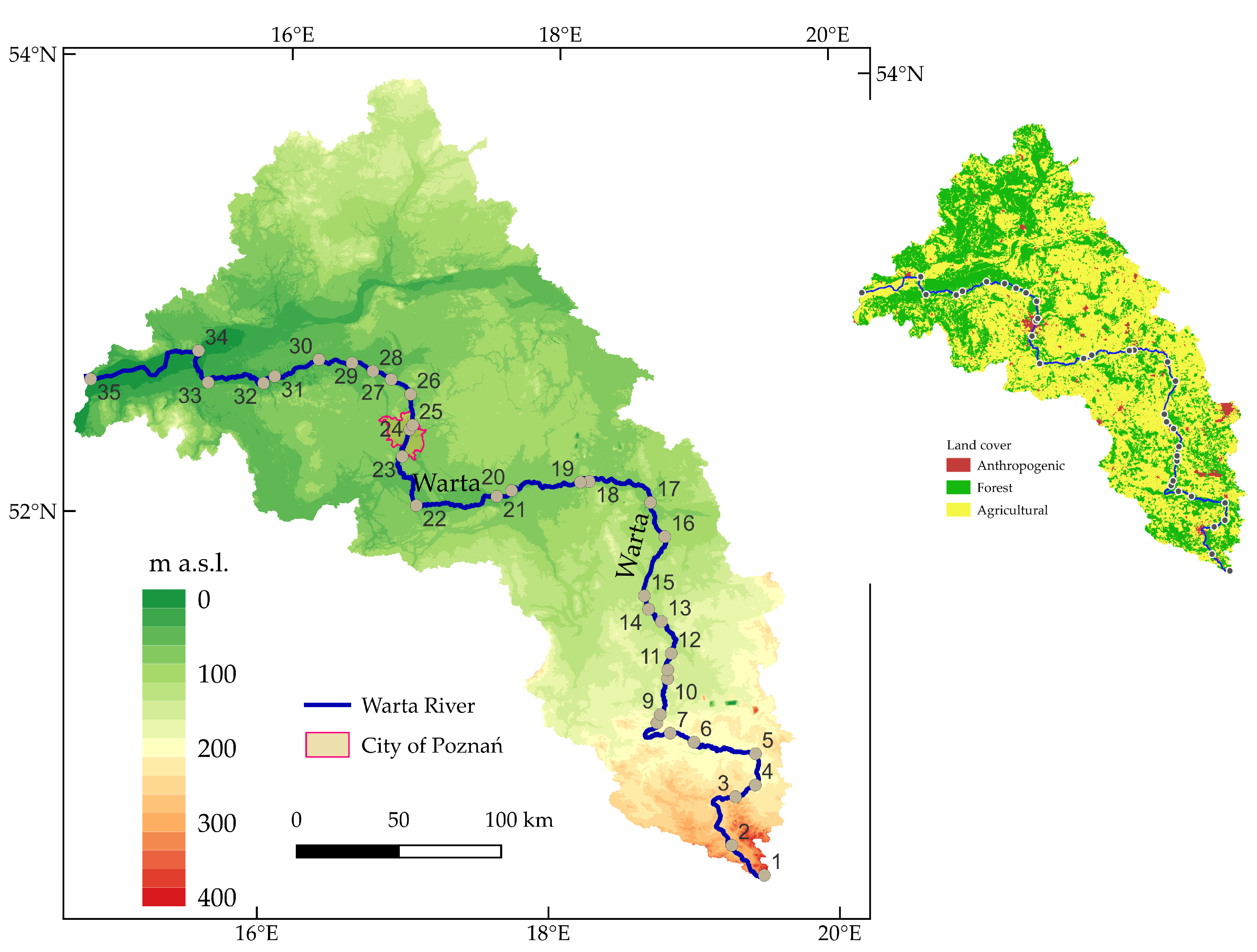
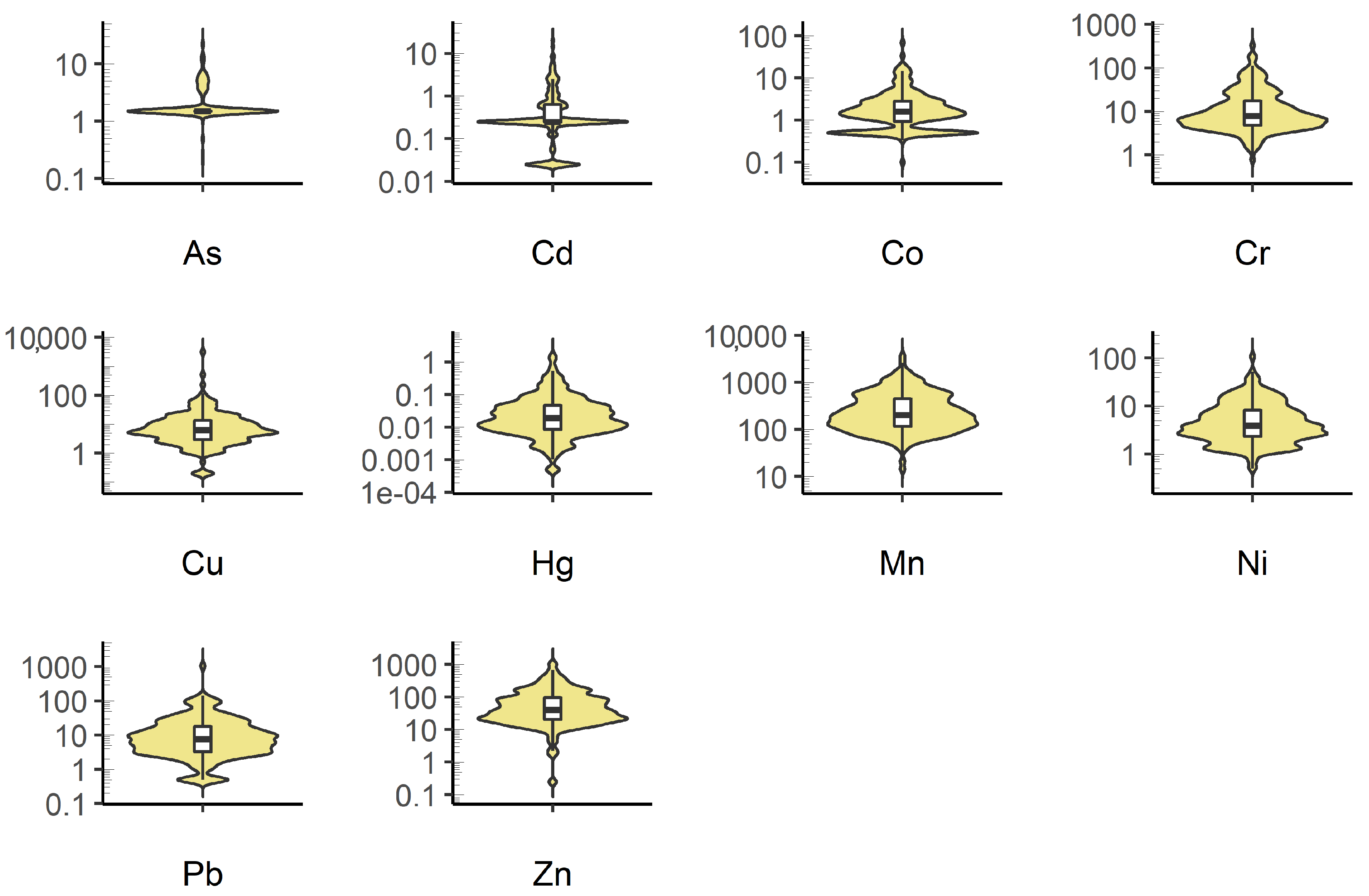
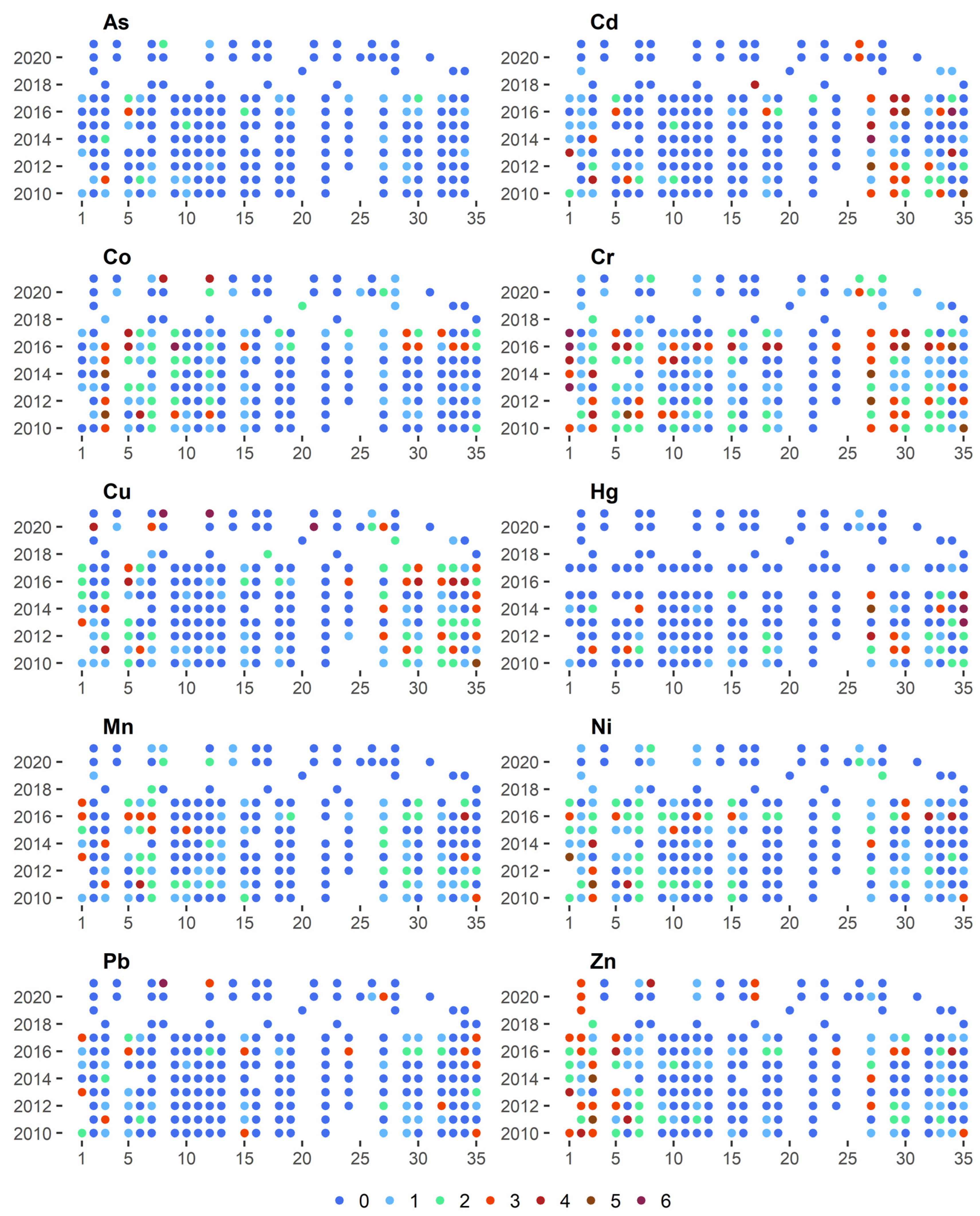
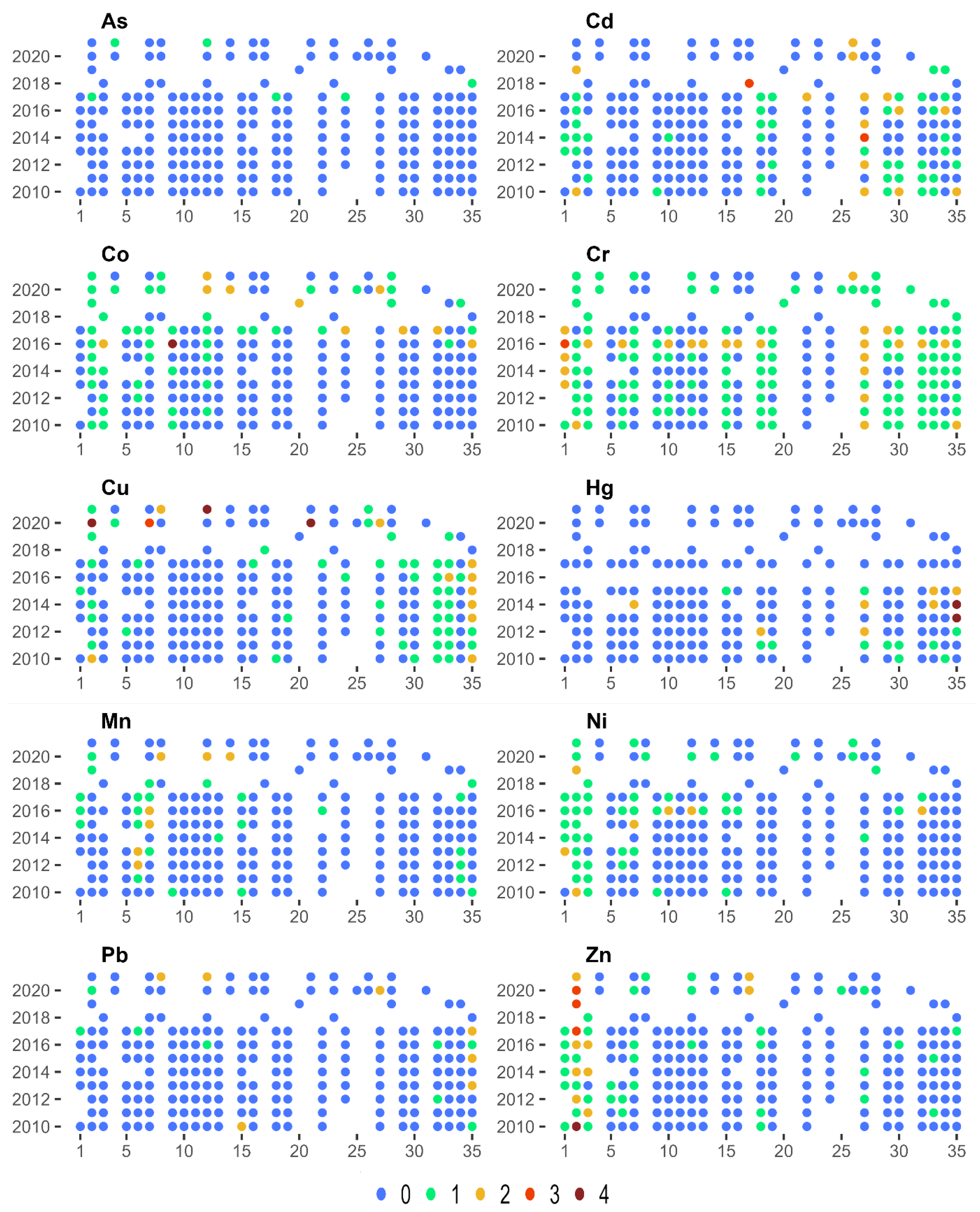
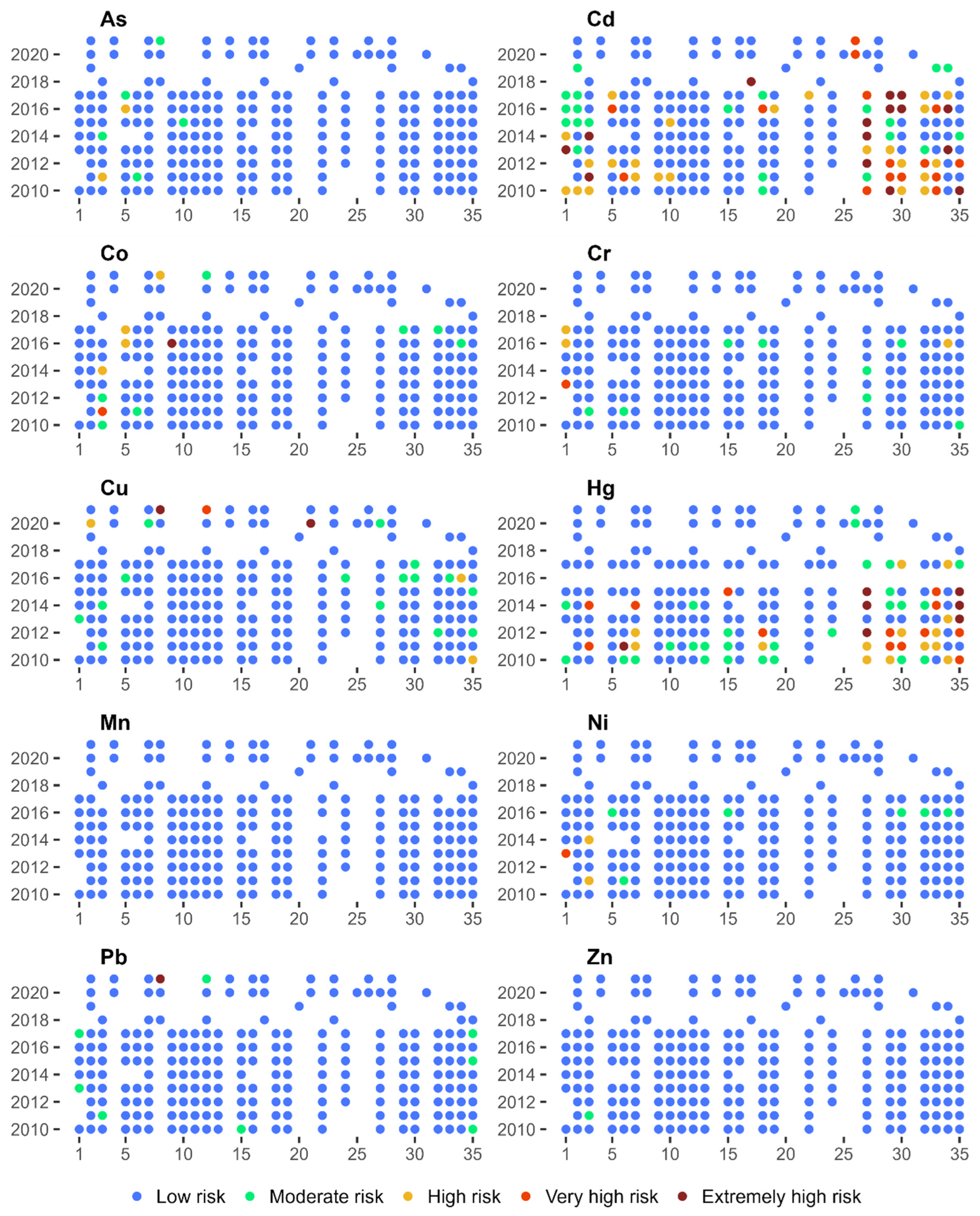
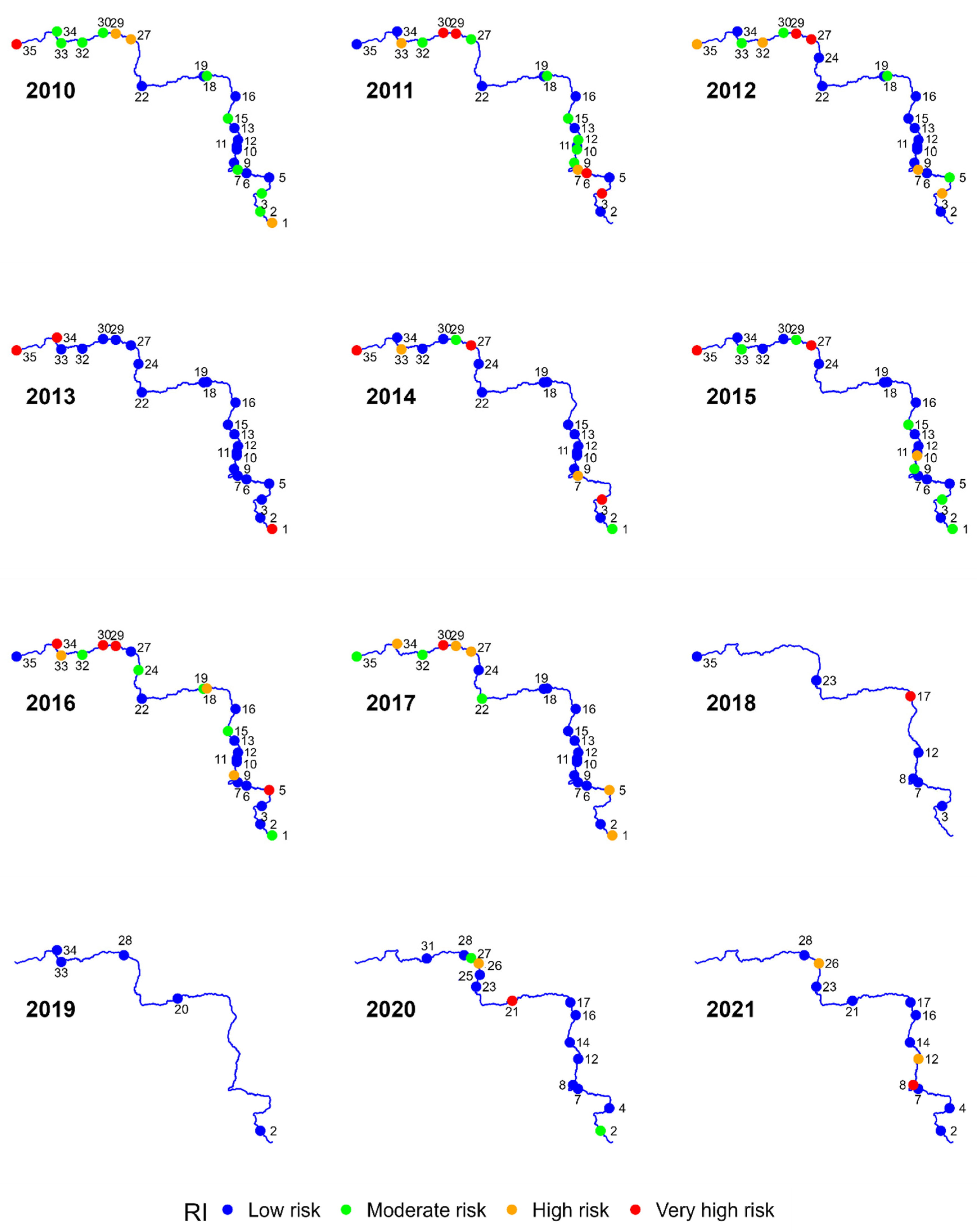

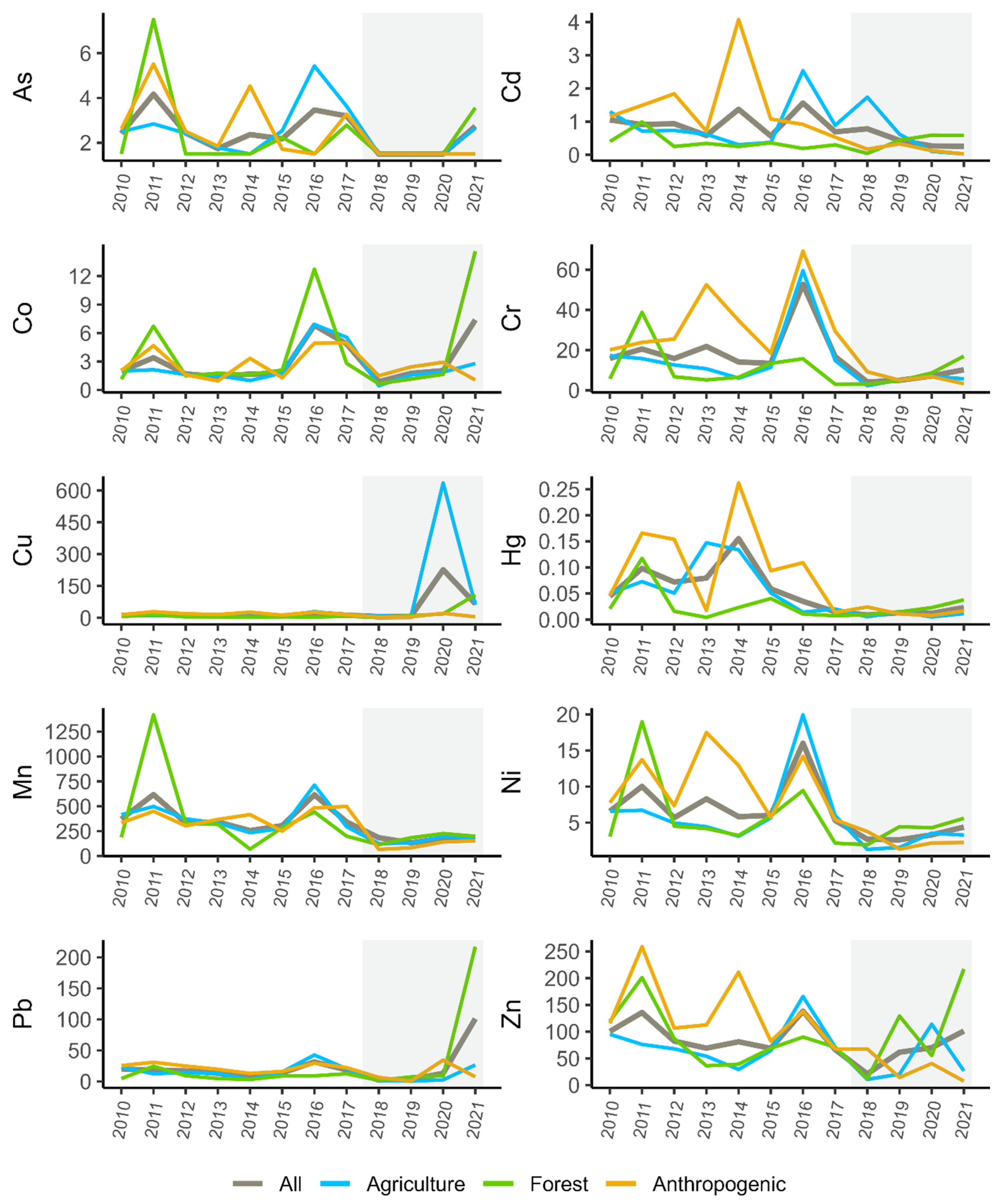
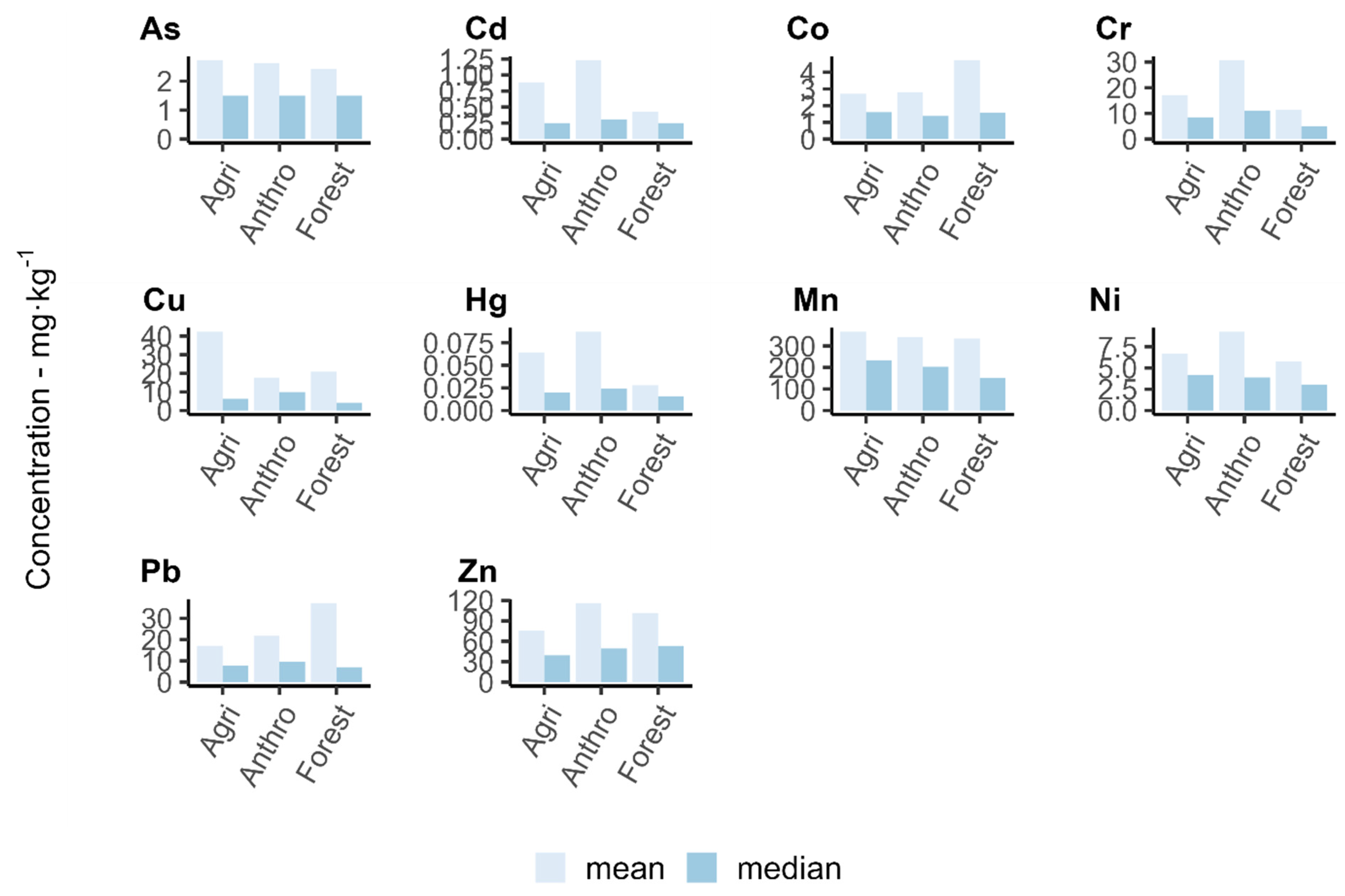
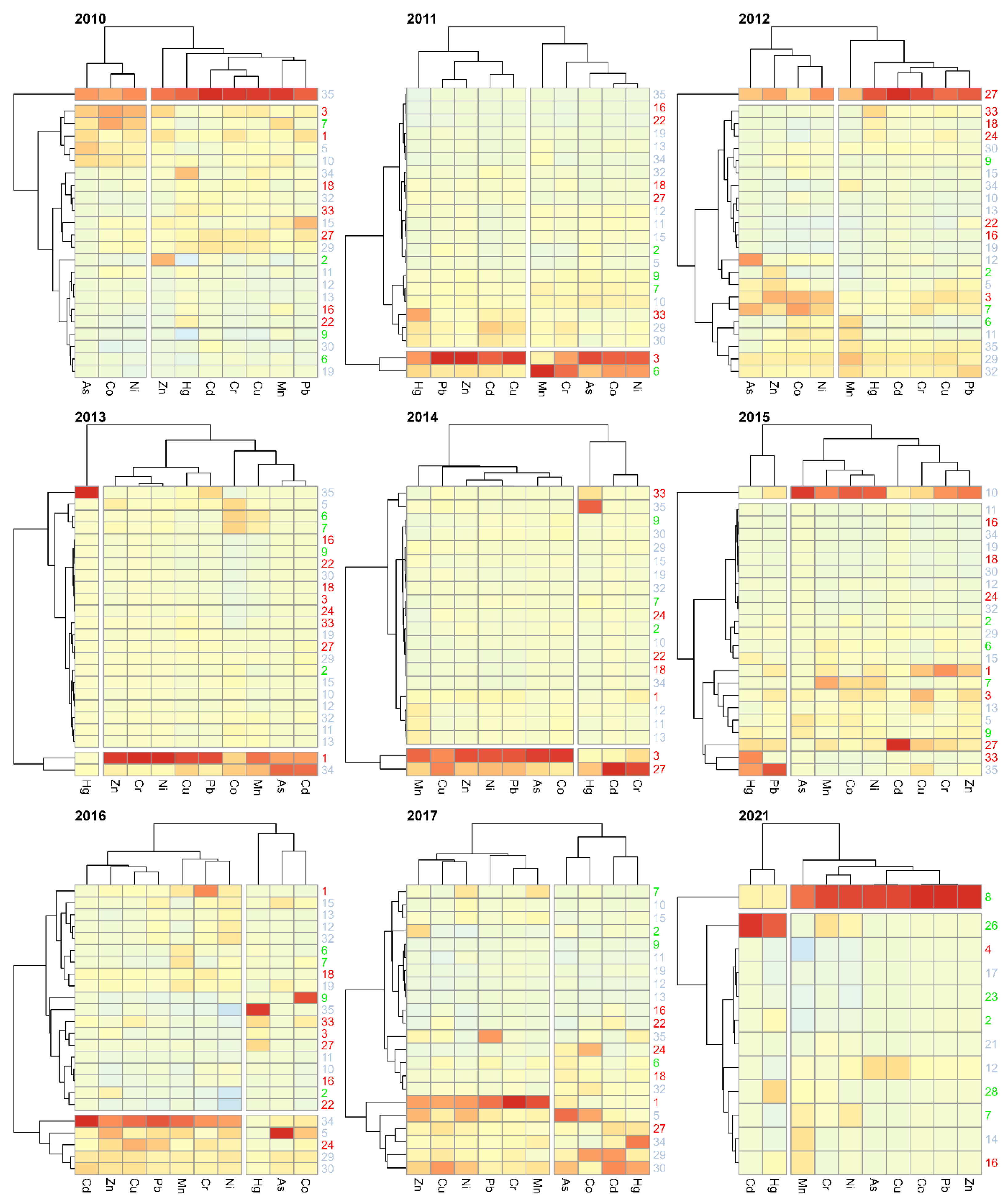
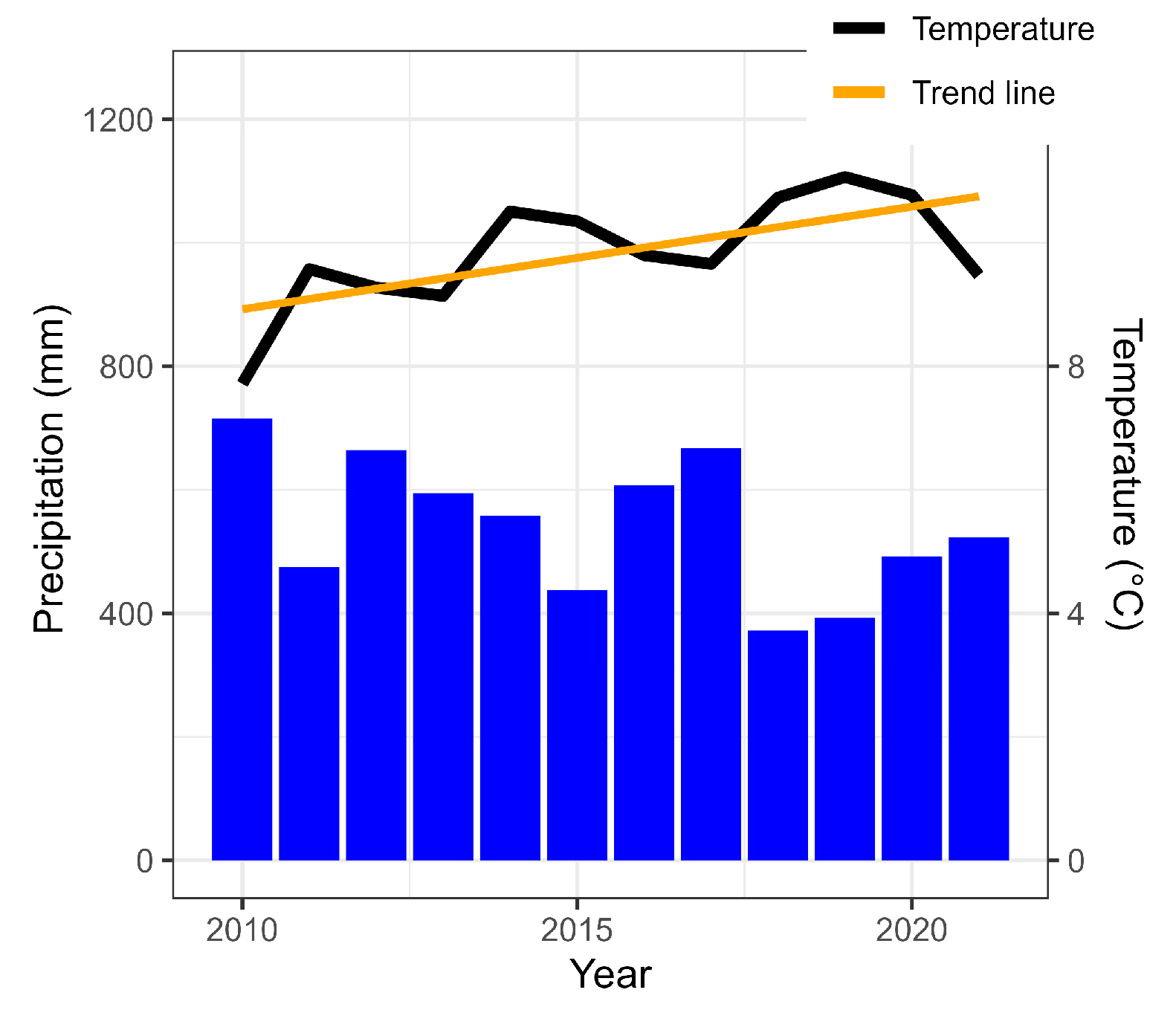
| Heavy Metal | TEL | PEL |
|---|---|---|
| As | 7.2 | 41.6 |
| Cd | 0.68 | 4.2 |
| Cr | 52.3 | 160.4 |
| Cu | 18.7 | 108.2 |
| Ni | 15.9 | 42.8 |
| Pb | 30.2 | 112.2 |
| Zn | 124 | 271 |
| Area Use | Site No. |
|---|---|
| Agricultural | 5, 10, 11, 12, 13, 14, 15 17, 19, 21, 29, 30, 31, 32, 34, 35 |
| Forest | 2, 6, 7, 8, 9, 23, 26, 28 |
| Anthropogenic | 1, 3, 4, 16, 18, 20, 22, 24, 25, 27, 33 |
| As | Cd | Co | Cr | Cu | Hg | Mn | Ni | Pb | Zn | TOC | pH | |
|---|---|---|---|---|---|---|---|---|---|---|---|---|
| Sampling sites | ||||||||||||
| min | 0.198 | 0.025 | 0.10 | 0.782 | 0.20 | 0.0005 | 14.4 | 0.50 | 0.50 | 0.25 | 0.05 | 6.10 |
| mean | 2.59 | 0.852 | 3.05 | 19.08 | 29.23 | 0.0615 | 359.9 | 7.20 | 20.75 | 88.59 | 1.86 | 7.66 |
| median | 1.5 | 0.25 | 1.59 | 7.78 | 6.16 | 0.0190 | 204.8 | 3.92 | 7.71 | 40.25 | 0.51 | 7.62 |
| max | 22.9 | 20.21 | 69.15 | 33.16 | 3170 | 1.57 | 3644 | 107.1 | 1050 | 1050 | 51.50 | 8.93 |
| sd | 2.87 | 2.01 | 5.90 | 33.9 | 214.6 | 0.1614 | 428.5 | 10.1 | 72.8 | 138.6 | 4.20 | 0.42 |
| skew | 4.05 | 6.13 | 7.39 | 5.22 | 14.05 | 6.53 | 3.54 | 5.41 | 12.61 | 4.09 | 8.06 | −0.32 |
| curtosis | 20.6 | 47.1 | 72.1 | 36.6 | 202 | 50.3 | 18.6 | 44.1 | 174.1 | 21.4 | 86.7 | 1.2 |
| IQR | 0 | 0.389 | 1.92 | 12.7 | 10.7 | 0.0388 | 334 | 5.86 | 14.5 | 74.8 | 1.69 | 0.50 |
| Geochemical background | ||||||||||||
| mean | 2.50 | 0.42 | 1.49 | 4.74 | 5.49 | 0.046 | 194.5 | 3.53 | 16.83 | 40.49 | ||
| sd | 0 | 0.43 | 0.71 | 3.41 | 2.13 | 0.024 | 49.3 | 1.43 | 12.38 | 15.83 | ||
| As | Cd | Co | Cr | Cu | Hg | Mn | Ni | Pb | Zn | TOC | |
|---|---|---|---|---|---|---|---|---|---|---|---|
| Cd | 0.38 | ||||||||||
| Co | 0.57 | 0.29 | |||||||||
| Cr | 0.56 | 0.63 | 0.59 | ||||||||
| Cu | 0.47 | 0.61 | 0.48 | 0.73 | |||||||
| Hg | 0.37 | 0.53 | 0.16 | 0.64 | 0.57 | ||||||
| Mn | 0.43 | 0.41 | 0.60 | 0.67 | 0.44 | 0.37 | |||||
| Ni | 0.57 | 0.47 | 0.76 | 0.82 | 0.59 | 0.48 | 0.78 | ||||
| Pb | 0.55 | 0.57 | 0.52 | 0.74 | 0.76 | 0.61 | 0.53 | 0.65 | |||
| Zn | 0.59 | 0.57 | 0.58 | 0.73 | 0.68 | 0.53 | 0.56 | 0.74 | 0.76 | ||
| TOC | 0.28 | 0.08 | 0.41 | 0.34 | 0.37 | 0.19 | 0.33 | 0.37 | 0.29 | 0.31 | |
| pH | −0.11 | 0.01 | −0.26 | −0.05 | −0.03 | 0.13 | −0.02 | −0.02 | −0.13 | −0.10 | −0.11 |
 p < 0.0001,
p < 0.0001,  p < 0.001,
p < 0.001,  p < 0.01,
p < 0.01,  p < 0.05.
p < 0.05.Disclaimer/Publisher’s Note: The statements, opinions and data contained in all publications are solely those of the individual author(s) and contributor(s) and not of MDPI and/or the editor(s). MDPI and/or the editor(s) disclaim responsibility for any injury to people or property resulting from any ideas, methods, instructions or products referred to in the content. |
© 2023 by the author. Licensee MDPI, Basel, Switzerland. This article is an open access article distributed under the terms and conditions of the Creative Commons Attribution (CC BY) license (https://creativecommons.org/licenses/by/4.0/).
Share and Cite
Fiedler, M. Long-Term Changes in the Pollution of Warta River Bottom Sediments with Heavy Metals, Poland—Case Study. Int. J. Environ. Res. Public Health 2023, 20, 5869. https://doi.org/10.3390/ijerph20105869
Fiedler M. Long-Term Changes in the Pollution of Warta River Bottom Sediments with Heavy Metals, Poland—Case Study. International Journal of Environmental Research and Public Health. 2023; 20(10):5869. https://doi.org/10.3390/ijerph20105869
Chicago/Turabian StyleFiedler, Michał. 2023. "Long-Term Changes in the Pollution of Warta River Bottom Sediments with Heavy Metals, Poland—Case Study" International Journal of Environmental Research and Public Health 20, no. 10: 5869. https://doi.org/10.3390/ijerph20105869
APA StyleFiedler, M. (2023). Long-Term Changes in the Pollution of Warta River Bottom Sediments with Heavy Metals, Poland—Case Study. International Journal of Environmental Research and Public Health, 20(10), 5869. https://doi.org/10.3390/ijerph20105869








